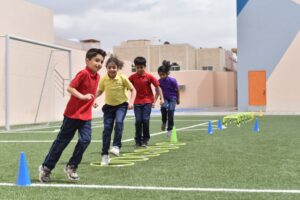As learners progress through early adolescence, the transition from primary to middle school introduces heightened expectations. While Riyadh is home to some of the best primary schools in the world, children still require ample support during this transformative period. Understanding the challenges enables a collaborative effort between parents and teachers that will ease students into larger campuses, diverse classrooms, and the multi-faceted expectations of multiple teachers, fostering a smoother transition into this significant phase of education.
This blog will take up the nuances of this transition – from primary to middle school and share some crucial strategies to apply in the classroom to make this shift smooth for learners.
Why the shift?
In the earlier years, the focus was on building foundational connections and memorizing routine knowledge, both academically and socially. This period serves to automate skills, freeing up mental resources for more complex tasks.
Upon entering middle school, students’ cognitive landscape expands. Increased emphasis on inferential thinking demands active decision-making about what knowledge is stored in short- or long-term memory. While the expectation is mastery of basic concepts, teachers must assist students by identifying the unique challenges students come across during this developmental shift.
The journey to becoming successful middle school students is gradual, requiring teachers’ savvy approach to imparting deeper content and maintaining engaging communication.
Strategies for a smooth transition
By focusing on effective communication in school transition, conducting middle school orientation programs, and encouraging peer support, the school ensures a seamless transition for students and their families.
Here are a few of the most important strategies that can help learners get through this transition phase.
Organizing a middle school visit
One crucial strategy to ease the transition is organizing a visit to the middle school. Collaborative efforts between elementary and middle school teachers play a pivotal role, facilitating practical skill development and fostering a positive school climate. Families get an opportunity to explore the campus, meet prospective teachers, school counselors, and principals during these visits. Importantly, students engage in activities that help them practice new skills, such as switching classes and navigating a larger campus. This firsthand experience not only diminishes apprehensions but also strengthens the sense of belonging, ensuring a smoother transition into the middle school environment.
Learning new rules and expectations
As students transition to middle school, addressing and adapting to new rules and expectations is a key focus. Teachers should identify students’ concerns about consequences and participation in various activities during this shift. To alleviate these concerns, the school should employ strategies involving middle school teachers or administrators visiting elementary classrooms. This approach not only introduces the rules but also fosters a sense of community by involving students in rule creation, giving them a voice in shaping their learning environment.
Nurturing such an inclusive classroom culture deepens learners’ connection to the school community. Furthermore, insights from older students are integrated into the process, providing valuable perspectives on expectations. Resources, including student handbooks and informational sessions for parents, enhance collaboration between school and home, emphasizing the importance of parental support during transitions.
Interacting with older students:
Addressing the dynamics of interacting with older students is a paramount aspect of a smooth transition. Older students play a vital role in the transition process, contributing to positive interactions during school tours and serving as mentors. The initiative to have older students assist with school tours for incoming students and families fosters a sense of community and provides younger students with positive role models.
Additionally, peer support during school transitions pairs younger students with older mentors, facilitating meaningful connections. This not only promotes a supportive environment but also contributes to stronger connectedness, interpersonal skills, and conflict resolution, ensuring a positive experience for all students in their new school environment.
Supporting parents as they help their children transition from Elementary to Middle School
Supporting parents during their child’s transition from elementary to middle school is crucial for fostering a smooth experience. Here are key strategies for parents:
Open communication channels
Encouraging parents to maintain open lines of communication with their children is necessary. Facilitating discussions about fears, expectations, and aspirations creates a supportive environment where children feel understood and valued. This communication fosters a sense of security during the transition.
Familiarize with the school environment
Guiding parents to actively explore middle school alongside their children can significantly alleviate anxieties. Familiarity with classrooms, facilities, and meeting teachers provides a good understanding of the new academic environment. This firsthand experience enhances parents’ ability to support their children effectively.
Attend orientation programs
Emphasizing the importance of parental attendance at school orientation programs is crucial. These sessions offer invaluable insights into the curriculum, school culture, and expectations. Informed parents can provide targeted support, aligning their guidance with the school’s vision and ensuring a smoother transition for their children.
Emphasize the importance of independence
Highlighting the significance of fostering independence in middle schoolers is a key aspect of parental support. Encouraging parents to gradually entrust their children with more responsibilities empowers the students to get through the increased academic and social expectations independently.
Establish a homework routine
Advocating for the creation of a consistent homework routine at home is essential. This not only aids in managing heightened academic demands but also establishes a conducive learning environment. A structured homework routine contributes to a sense of stability during this period of change.
These strategies make parents integral partners in the transition process. The collaborative efforts between parents and educators ensure a comprehensive support system, paving the way for a successful and positive move to middle school.
Conclusion
The transition from elementary to middle school marks a significant chapter for students and their families. Effective communication, comprehensive orientation programs, and a supportive community are the cornerstones of a seamless transition that help learners embark on their middle school journey with confidence, from a strong foundation for success.
Moreover, schools worldwide can draw inspiration from these principles. One World International School, Riyadh, focuses on creating an ecosystem where students thrive during this critical phase. Such practices reinforce the school’s commitment to holistic learning that contributes to the success of students at every stage.
OWIS Riyadh Communications Team
-
OWIS Riyadh Communications Team#molongui-disabled-link
-
OWIS Riyadh Communications Team#molongui-disabled-link
-
OWIS Riyadh Communications Team#molongui-disabled-link
-
OWIS Riyadh Communications Team#molongui-disabled-link











